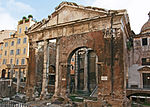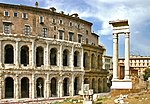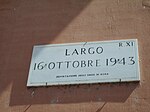Sant'Angelo in Pescheria

Sant'Angelo in Pescheria or in Piscaria is a church in Rome. It dates from the 8th century. "In Pescheria" refers to its location close to the fish market built in the ruins of the ancient Porticus Octaviae. The relics of St. Symphorosa and her seven sons were transferred to the Church of Sant'Angelo in Pescheria at Rome by Pope Stephen II in 752. A sarcophagus was found here in 1610, bearing the inscription: Hic requiescunt corpora SS. Martyrum Simforosae, viri sui Zotici (Getulii) et Filiorum ejus a Stephano Papa translata. This inscription refers to Saint Getulius and Saint Symphorosa, purported to be husband and wife, who had seven sons, who were also martyred. The remains of these saints were transferred to Sant'Angelo by Pope Stephen II in 752.The revolutionary "tribune" Cola di Rienzo was born near Sant'Angelo. He launched his effort to seize control of Rome from the vicinity of the church in 1347. The Roman Ghetto was established nearby in the rione Sant'Angelo in 1555 by order of Pope Paul IV. The Ghetto was abolished in 1870 after the reunification of Italy or Risorgimento, and the Ghetto wall was demolished in 1888. The rione Sant'Angelo, numbered as XI, is named after the church. The inscriptions found in S. Angelo, a valuable source illustrating the history of the Basilica, have been collected and published by Vincenzo Forcella.In the second chapel to the left inside the church are frescoes of the Madonna with Child and Angels attributed to Benozzo Gozzoli (c. 1450). During the late 14th century, Matteo de Baccari dedicated part of his inheritance to the Church of Sant'Angelo in Pescheria in Rome, specifically to the Chapel of St. Cosmo and Damian. The chapel was not operational, but after many years his daughter, Mattea, managed to make the chapel functional. The Church is currently in the possession of the Order of Clerics Regular Minor, which utilizes the attached convent as their Generalate House.
Excerpt from the Wikipedia article Sant'Angelo in Pescheria (License: CC BY-SA 3.0, Authors, Images).Sant'Angelo in Pescheria
Via di Sant'Angelo in Pescheria, Rome Municipio Roma I
Geographical coordinates (GPS) Address External links Nearby Places Show on map
Geographical coordinates (GPS)
| Latitude | Longitude |
|---|---|
| N 41.8927 ° | E 12.4787 ° |
Address
Sant’Angelo in Pescheria
Via di Sant'Angelo in Pescheria
00186 Rome, Municipio Roma I
Lazio, Italy
Open on Google Maps











